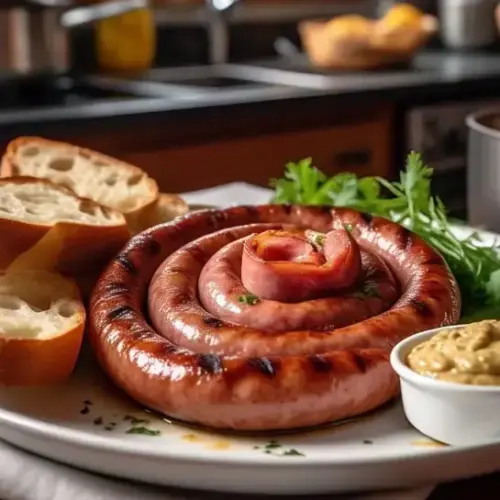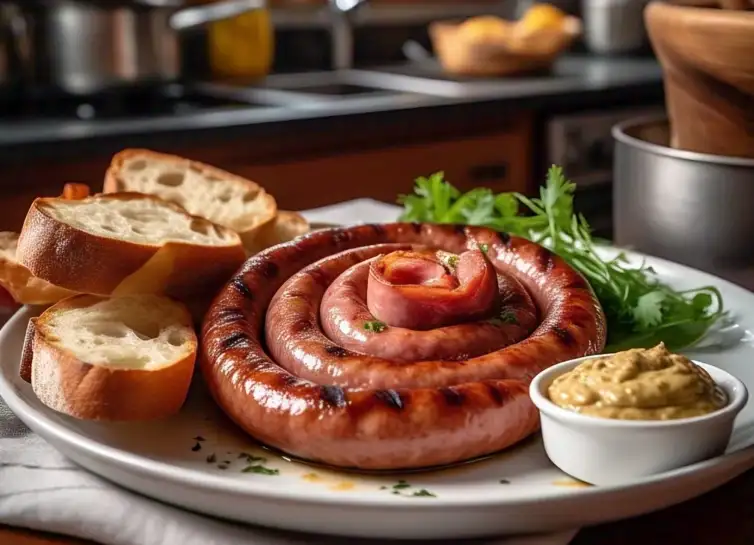Rosebud Sausage has been a beloved part of Chicago’s culinary scene since the early 1900s. Known for its premium quality, distinct flavors, and cultural significance, Rosebud Sausage is more than just a food product—it’s a tradition. This article delves into the history, product offerings, and cultural impact of this iconic brand.
TL;DR
- Rosebud Sausage & Meat Company is a historic brand originating in Chicago, Illinois.
- Signature products include Polish Sausage and Italian Sausage, rooted in immigrant culinary traditions.
- Known for handcrafted recipes, premium quality, and strong ties to Chicago food culture.
- Available in local delis, grocery chains, and featured at events like the Taste of Chicago Festival.
- Competitors include Vienna Beef and Johnsonville, but Rosebud’s authenticity sets it apart.
History and Heritage of Rosebud Sausage
Founding Era: A Legacy Begins
Rosebud Sausage & Meat Company was founded in the early 1900s, during Chicago’s peak as a meatpacking hub. Immigrants from Europe brought their traditional sausage-making techniques, which became the backbone of the brand. The company’s recipes have remained largely unchanged, preserving the authenticity that made them a household name. Customers especially value the bold, savory flavors and the use of traditional spice blends that harken back to old-world techniques. This commitment to heritage ensures each bite delivers the rich taste and texture synonymous with Rosebud Sausage.
Chicago Stockyards and Meatpacking Legacy
The brand’s early success was closely tied to the historic Chicago Stockyards, a center for the meat processing industry. Rosebud Sausage thrived by maintaining high standards in sourcing and production, ensuring a consistent product that resonated with the local community.
Cultural Significance
As Chicago grew, Rosebud Sausage became a staple at delis, diners, and sporting events. Its reputation as “Chicago’s Finest” highlights its deep connection to the city’s identity. Today, it’s a symbol of local pride, often featured at community events like the Taste of Chicago Festival, where visitors savor its Polish Sausage while recalling fond memories of shared meals and Chicago traditions. For example, at the annual festival, families frequently reminisce about how Rosebud’s flavors evoke summer barbecues and sporting event cookouts, cementing its role as a cherished part of Chicago’s cultural fabric.

Sausage, Peppers & Pasta Recipe
Ingredients
- Spice Blend
- 2 tsp Italian seasoning
- 2 tsp dried basil
- 1 tsp fine sea salt
- 1 tsp garlic powder
- 1 tsp onion powder
- ½ tsp black pepper
- Main Ingredients
- 1 lb Rosebud Italian sausage sweet, hot, or mild
- 2 Vidalia onions sliced
- 2 green 1 red, 1 yellow, 1 orange bell peppers, sliced
- 1½ cups beef stock adjust for cooking method
- 8 oz penne pasta
- 2 Tbsp brown sugar optional
- 2 Tbsp balsamic vinegar
- 14.5 oz fire-roasted tomatoes
- 1 bulb roasted garlic or 1 tsp minced garlic
- 6 oz tomato paste
- 1½ cups shredded Italian cheese blend mozzarella, parmesan, etc.
- 1 Tbsp olive oil
Instructions
- Dutch Oven Method
- Brown Sausage & Veggies: Heat olive oil in a Dutch oven. Add sausage (cut into 2″ pieces) and brown. Remove, then sauté onions and peppers with salt and pepper until tender.
- Deglaze & Simmer: Add beef stock (use 2 cups), scraping browned bits. Stir in pasta, tomatoes, spice blend, roasted garlic, brown sugar, balsamic vinegar, and sausage.
- Cook Pasta: Simmer covered until pasta is al dente (~15 minutes). Stir in tomato paste.
- Broil Cheese: Top with cheese, broil in oven 3–5 minutes until bubbly.
- Skillet & Pot Method
- Cook Pasta: Boil penne until 90% done. Drain and set aside.
- Sauté Sausage & Veggies: In a skillet, brown sausage, then add onions and peppers. Cook until tender.
- Combine: Transfer sausage, veggies, pasta, tomatoes, spice blend, garlic, and ½ cup beef stock to a large pot. Stir in tomato paste.
- Bake: Top with cheese, bake at 350°F for 15–20 minutes. Broil to brown cheese.
- Slow Cooker Method
- Sauté Sausage: Brown sausage in a skillet. Transfer to slow cooker.
- Add Base Ingredients: Add pasta, tomatoes, spice blend, roasted garlic, and 2 cups beef stock. Cook on high 2–3 hours.
- Add Veggies & Finish: Stir in sautéed veggies and tomato paste. Cook 30 minutes. Transfer to a dish, top with cheese, and broil.
- Ninja Foodi/Instant Pot Method
- Sear Sausage: Use Sauté mode to brown sausage. Remove.
- Cook Veggies: Sauté onions/peppers in remaining oil. Deglaze with beef stock.
- Pressure Cook: Add sausage, pasta, tomatoes, garlic, spice blend, brown sugar, vinegar, and tomato paste (do not stir). Pressure cook on high 4 minutes, NPR 2 minutes.
- Crisp Cheese: Stir in veggies. Top with cheese, Air Crisp at 400°F for 5 minutes.
Product Offerings and Quality
Signature Products
Rosebud Sausage is best known for its Polish Sausage and Italian Sausage. These products stand out for their rich flavor, juicy texture, and signature snap. Other offerings include:
- Bratwurst: A German-inspired sausage with mild spices.
- Smoked Meats: Including bacon and ham, perfect for a variety of dishes.
- Hot Dogs: Classic Chicago-style with premium cuts of meat.
Traditional Production Methods
Rosebud Sausage relies on time-honored techniques such as slow smoking over hardwood. Each sausage is carefully seasoned with natural spices, ensuring a savory and authentic flavor profile. The use of high-quality pork, beef, and poultry sets the brand apart from competitors.
Packaging and Distribution
Products are vacuum-sealed to preserve freshness and are available in bulk or family-sized packs. Rosebud Sausage is primarily distributed in the Midwest, with select products reaching national markets through partnerships with grocery chains like Jewel-Osco.
Culinary and Cultural Impact
A Staple of Chicago Cuisine
Rosebud Sausage plays a significant role in Chicago food culture. It’s a key ingredient in classic dishes such as:
- Chicago-style hot dogs: Served with mustard, relish, onions, and a pickle spear.
- Deep-dish pizza: Often topped with Italian sausage for a hearty, flavorful kick.
- Grilled sausages: A summer favorite at backyard barbecues and festivals.
Nostalgia and Tradition
The brand evokes a sense of nostalgia for many Chicagoans who grew up enjoying its products at family gatherings and local diners. Its association with iconic venues and street fairs solidifies its place in the city’s culinary history.
Events and Festivals
Rosebud Sausage is frequently showcased at the Taste of Chicago Festival and other community events. These platforms not only promote the brand but also celebrate Chicago’s rich culinary traditions.
Competitive Landscape
Competitors
Rosebud faces competition from national brands like Vienna Beef and Johnsonville. However, its focus on regional authenticity and traditional recipes gives it a competitive edge.
Differentiation
What sets Rosebud apart is its commitment to quality and heritage. Unlike mass-produced sausages, Rosebud products emphasize small-batch craftsmanship and local sourcing. This appeals to consumers seeking authentic, high-quality food.
Partnerships
Collaborations with restaurants like Rosebud Restaurants and local delis strengthen the brand’s presence in Chicago. These partnerships ensure that Rosebud products remain a favorite among both residents and visitors.
Marketing and Customer Engagement
Branding
Rosebud Sausage is marketed as “Chicago’s Finest,” a slogan that underscores its local roots and premium quality. The brand’s visual identity features bold lettering and classic designs that evoke tradition.
Digital Presence
The company actively engages with customers through its website and social media platforms. Recipes, cooking tips, and brand stories are shared to connect with a broader audience.
Customer Loyalty
Generational appeal is a hallmark of Rosebud Sausage. Families have trusted the brand for decades, passing down their love for its products to younger generations. This loyalty is a testament to the brand’s consistent quality and cultural relevance.
Conclusion
Rosebud Sausage is more than a product; it’s a Chicago institution. From its humble beginnings in the early 1900s to its status as a local icon, the brand has maintained a commitment to quality, tradition, and community. Whether enjoyed at a family barbecue or a neighborhood festival, Rosebud Sausage continues to bring people together with its timeless flavors.

